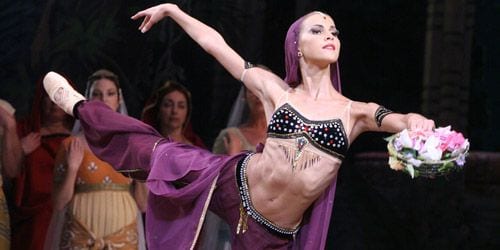
“It seems to me that ballet is first and foremost the art of the ballerina,” says Mariinsky Theater director Makhar Vasilyev. “It is a feminine art.” Certainly this is true in the visual arrangements of Ballerina, Bertrand Normand’s careful, respectful documentary on five dancers in the Kirov Ballet. The attention to women in the field is specific, intent, and so very old school. “Twenty years after perestroika,” narrates Diane Baker, “Russians still have their muse and St. Petersburg remains her main showcase. A symbol of tradition and yet thoroughly alive, she still draws crowds to theaters.”
But as the film begins with this invocation — to both a vaunted past and an unfolding future that can’t help but be affected by troubled economics — it doesn’t spend much time considering the hows and whys of the ballerinas’ popularity. Following some lovely shots of snowy St. Petersburg, the film offers a couple of girl-on-the-street interviews recalling childhood dreams and dashed hopes and set-up descriptions by women who oversee the esteemed Vaganova Academy. “We have particular demands,” says artistic director Alynay Asylmratova. “Ideally, a ballerina has a small head, long neck, long arms, long legs, a slender figure. It’s difficult to know with a 10-year-old what figure she’s going to have,” Indeed, the camera shows little girl after little girl, thin, pale, and determined, their hair tied tightly and their tiny arms posed into perfect curves. They’re all similar, their aspirations earnest, their bodies stretched and twisted.
Here the film cuts to 17-year-old Alina Somova, “in her final days at the dance school.” As she emerges from her cloistered student environment into the tougher world of professional dance, Alina is one of five ballerinas tracked throughout the film, each at a different stage in her career. Ballerina observes her rehearsing her exit performance of Paquita, which will determine whether she’s accepted into the Kirov. The theater stage is wide and the ceilings adorned with curtains and candelabras. She speaks of her success enthusiastically, a mic clipped to her fleece jacket and her face flushed, before the scene cuts to the Mariinsky theater, a handheld shot illustrating Baker’s assessment that the place is a “dizzying maze of constantly changing sets, corridors, and theater wings.” Here, the film asserts, Alina will spend long hours and commit herself to daunting work, a member of a huge company (120 women dancers and 100 men) at “the bottom of the ladder,” in the corps de ballet. Where she was a revered soloist at school, here she will have to prove herself again.
The likely next steps in Alina’s career are embodied by the other ballerinas interviewed here, including current corps de ballet member Evgenia Obraztsova. “The naïvete with which I started is perhaps still evident,” she smiles, “But now I understand better where I am. The theater is much more complicated than dance school.” Truisms maybe, but the film adeptly demonstrates both the art and the labor of ballet, the ravishing beauty of a strong performance, the sinewy forms almost rapturous in their contortions. Evgenia, who takes some time off to act in a French film, playing a character she says is much like herself, seems to appreciate every aspect of her profession, spending long minutes backstage signing autographs and accepting critiques from her dedicated “female fans,” one in literal tears as she imagines her idol is “on her way to becoming a prima ballerina.”
For all the majesty of the performance, for all the adulation heaped on the performers, the film insists that the costs are high: the dancers must be physically and mentally disciplined and relentlessly focused, especially those who aspire to become prima ballerinas (here the film offers a montage of photos of greats, from Anna Pavlova to Natalya Markarova. While men were particularly famous during the Soviet years (say, Baryshnikov), the documentary reports that after the 1990s, women were again ascendant.
One existing example, Ballerina proposes, is Diana Vishneva, less traditional than her contemporaries and working with multiple ballets (including Paris). She expresses her concern for the future: “The only big problem is the choreographers, the new stagings, meaning we preserve the basics of the classics. We restage modern ballet, but we don’t really have any new pieces.” As brilliantly as she performs Cinderella or Scheherazade, for instance, Diana is also unable to expand the horizons of her art. That said, she is striking — in the field on in this film — for her different “look,” her embodied sense of adventure. A French dance partner, Manuel Legris, says she’s “not like other ballerinas who focus on technique. She was the character… She’s not necessarily the ideal dancer in terms of textbook lines, with high kicks, but her intelligence and the way she presents herself on stage immediately mark her out.”
Here the film notes a fundamental contradiction in ballet as business and art, in its demand for conformity and delight in innovation. As thousands of youngsters put themselves through the early steps of Swan Lake each year, the industry seeks change, but not too much. Gauging that degree is complex, the expectations never quite clear. A ballerina should be able to “express herself” even as she bends her body into poses produced and reproduced by generations before her. Ulyana Lopatkina’s course has been slightly different from the usual: injured, she took time off to recover and have a daughter. Though her trainers and managers worry about her choices, she appears vindicated when choreographer Pierre Lacotte pronounces, “I think she’s come back even better.”
Repeatedly in Ballerina, long sequences of the dancers at work — some grandly made-up and costumed on stage, some artfully silhouetted in the rehearsal studio — reveal the effort and the effect of ballet. Without detailing difficulties and frustrations, or even triumphs, this observational film reflects in its alternately impressionistic and conventional form the tensions it records.

![Call for Papers: All Things Reconsidered [MUSIC] May-August 2024](https://www.popmatters.com/wp-content/uploads/2024/04/all-things-reconsidered-call-music-may-2024-720x380.jpg)



